 Technology peripherals
Technology peripherals
 AI
AI
 Kai-Fu Lee participated in Zero One Wish, which released a world-class open source multi-modal large model.
Kai-Fu Lee participated in Zero One Wish, which released a world-class open source multi-modal large model.
Kai-Fu Lee participated in Zero One Wish, which released a world-class open source multi-modal large model.
Leading the two authoritative lists in Chinese and English, Kai-Fu Zero handed over the multi-modal large model answer sheet!
It is less than three months since the release of its first open source large models Yi-34B and Yi-6B.

The model is called Yi Vision Language (Yi-VL), and it is now officially open source to the world.
belong to the Yi series and also have two versions:
Yi-VL-34B and Yi-VL-6B.
Let’s take a look at two examples first to experience Yi-VL’s performance in diverse scenarios such as graphic and text dialogues:
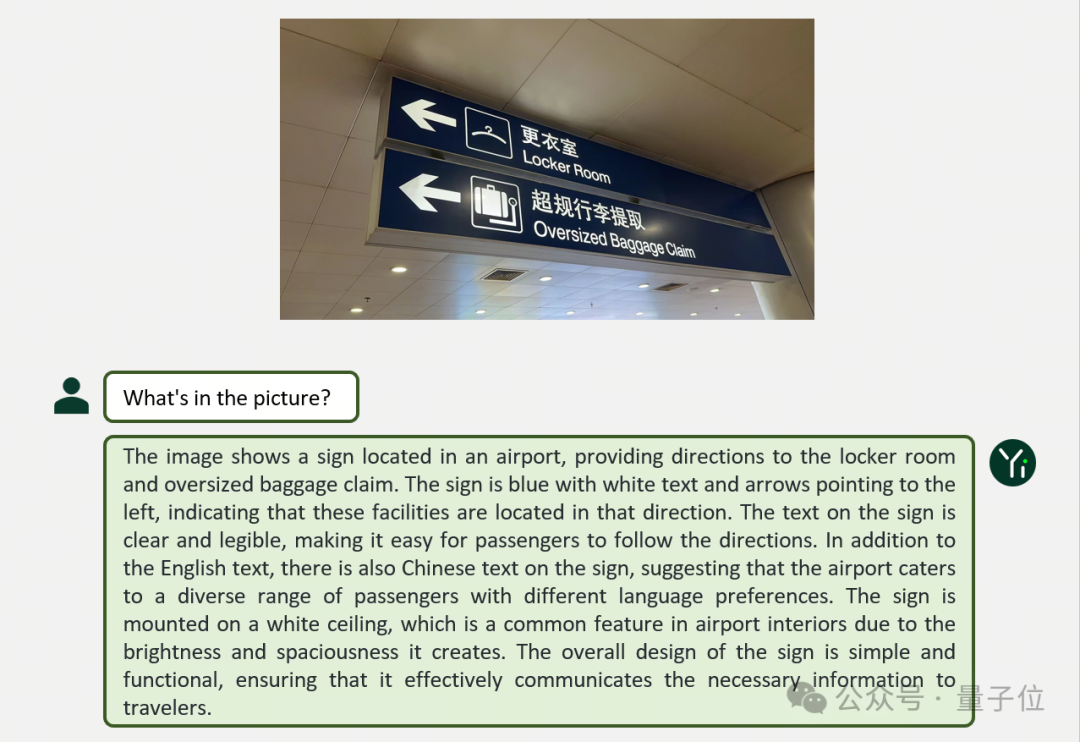
Yi-VL Each picture was analyzed in detail, not only explaining the content on the sign, but even taking care of the "ceiling".
In Chinese, Yi-VL can also express clearly and methodically accurately:
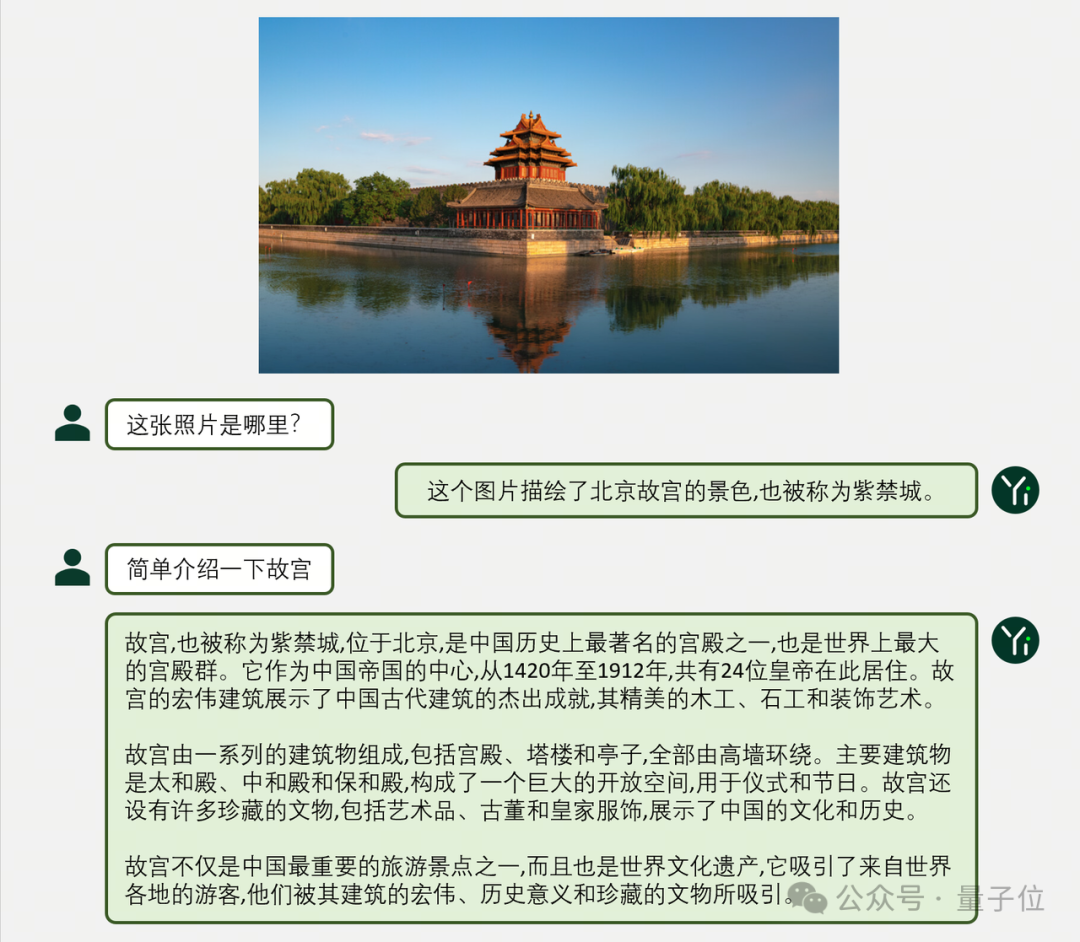
In addition, the official test results were also given.
Yi-VL-34B has an accuracy of 41.6% on the English data set MMMU, second only to GPT-4V with an accuracy of 55.7%, surpassing a series of multi-modal large models.
On the Chinese data set CMMMU, the accuracy of Yi-VL-34B is 36.5%, which is ahead of the current cutting-edge open source multi-modal models.
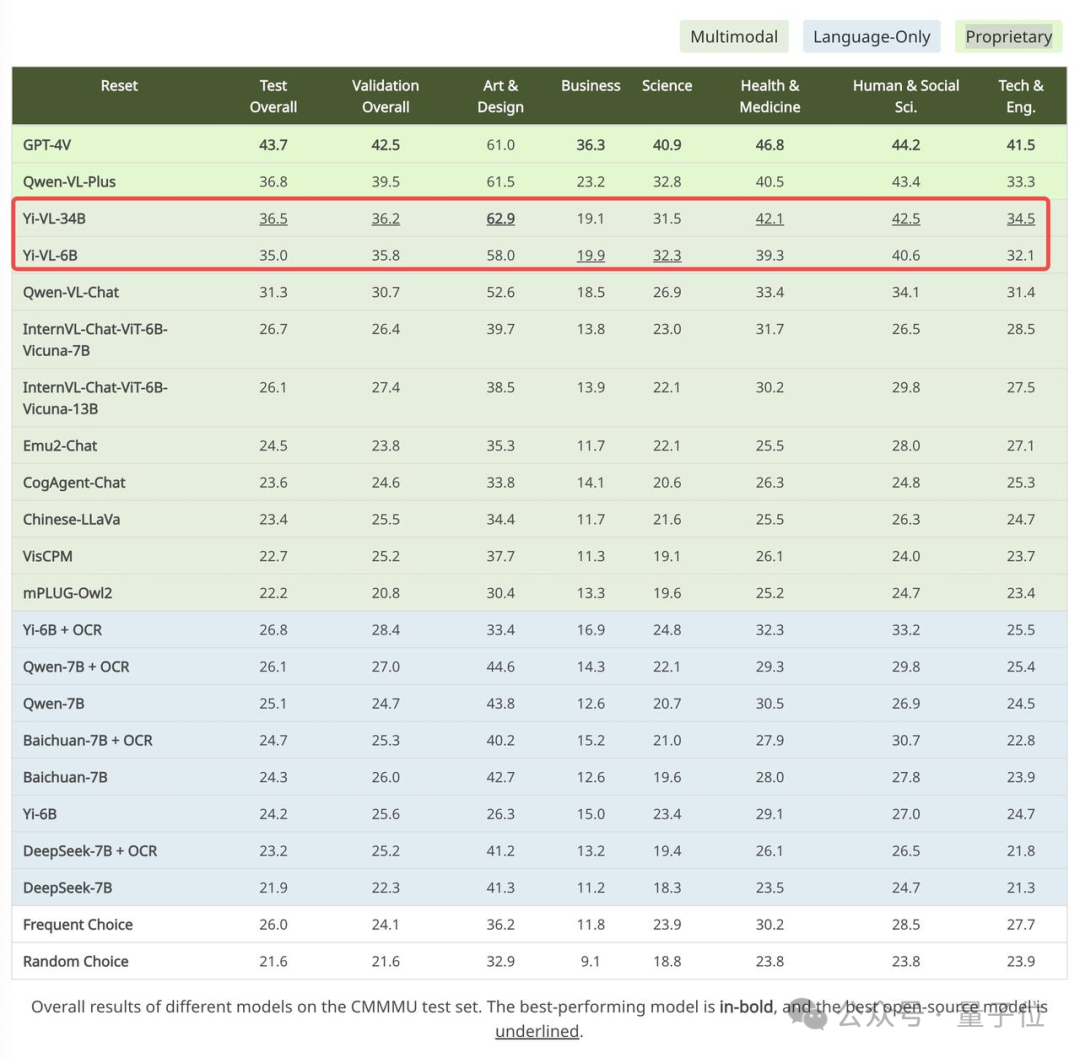
#What does Yi-VL look like?
Yi-VL is developed based on the Yi language model. You can see the powerful text understanding capabilities based on the Yi language model. You only need to align the pictures to get a good multi-modal visual language model - this is also One of the core highlights of the Yi-VL model.
In terms of architecture design, the Yi-VL model is based on the open source LLaVA architecture and contains three main modules:
- Vision Transformer (ViT for short) For image encoding, the open source OpenClip ViT-H/14 model is used to initialize the trainable parameters, and by learning to extract features from large-scale "image-text" pairs, the model has the ability to process and understand images.
- The Projection module brings the ability to spatially align image features and text features to the model. This module consists of a multilayer perceptron (Multilayer Perceptron, referred to as MLP) that contains layer normalizations. This design allows the model to more effectively fuse and process visual and text information, improving the accuracy of multi-modal understanding and generation. The introduction of Yi-34B-Chat and Yi-6B-Chat large language models provides Yi-VL with powerful language understanding and generation capabilities. This part of the model uses advanced natural language processing technology to help Yi-VL deeply understand complex language structures and generate coherent and relevant text output.
training method, Yi -The training process of the VL model is divided into three stages, aiming to comprehensively improve the model's visual and language processing capabilities.
In the first stage, the ViT and Projection modules are trained using 100 million "image-text" paired data sets. At this stage, the image resolution is set to 224x224 to enhance ViT’s knowledge acquisition capabilities in specific architectures while achieving efficient alignment with large language models. In the second stage, the image resolution of ViT is increased to 448x448, making the model better at recognizing complex visual details. About 25 million "image-text" pairs are used in this stage. In the third stage, the parameters of the entire model are opened for training, with the goal of improving the model's performance in multi-modal chat interaction. The training data covers diverse data sources, with a total of approximately 1 million "image-text" pairs, ensuring the breadth and balance of the data. The zero-yiwu technical team also verified that it can quickly train efficient images based on the Yi language model's powerful language understanding and generation capabilities using other multi-modal training methods such as BLIP, Flamingo, EVA, etc. A multimodal graphic-text model for understanding and smoothing graphic-text dialogue. Yi series models can be used as base language models for multi-modal models, providing a new option for the open source community. At the same time, the zero-one-things multi-modal team is exploring multi-modal pre-training from scratch to approach and surpass GPT-4V faster and reach the world's first echelon level.Currently, the Yi-VL model has been opened to the public on platforms such as Hugging Face and ModelScope. Users can personally experience the performance of this model in diverse scenarios such as graphic and text dialogues.
Beyond a series of large multi-modal models
In the new multi-modal benchmark test MMMU, both versions Yi-VL-34B and Yi-VL-6B performed well.
MMMU (full name Massive Multi-discipline Multi-modal Understanding & Reasoning Massive Multi-discipline Multi-modal Understanding and Reasoning) The data set contains 11,500 subjects from six core disciplines(Art & Design, Business, Science, Health & Medicine, Humanities & Social Sciences, and Technology & Engineering) questions involving highly heterogeneous image types and intertwined textual image information pose challenges to the model's advanced perception and reasoning capabilities met extremely high demands.

Yi-VL-34B successfully surpassed a series of multi-modal large models with an accuracy of 41.6% on this test set, second only to GPT-4V (55.7%), showing strong ability to understand and apply interdisciplinary knowledge.
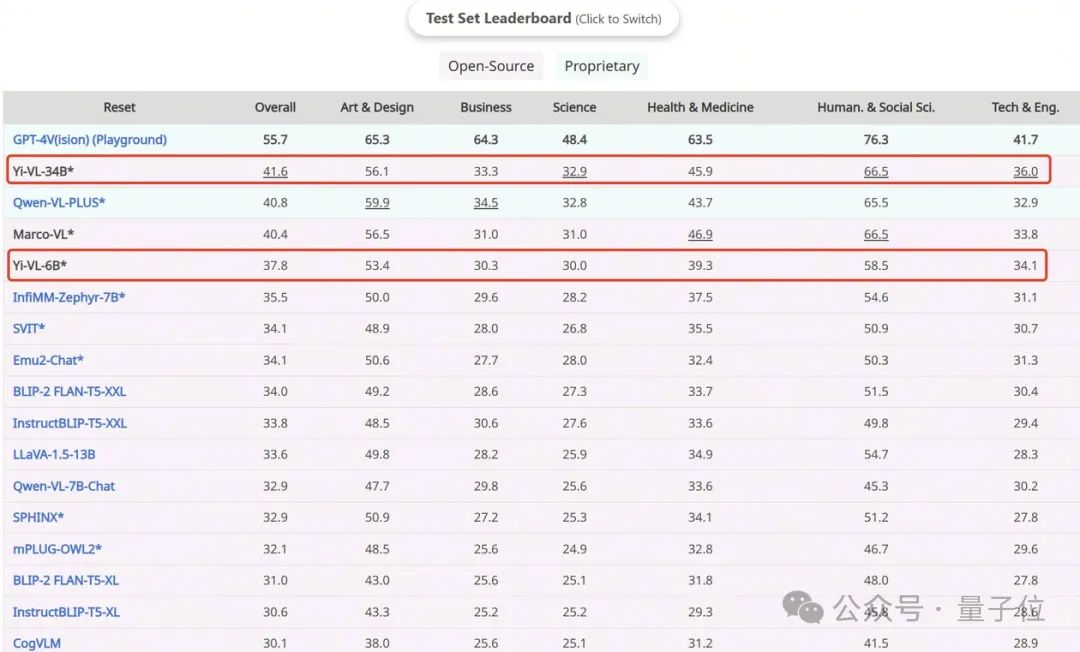
Similarly, on the CMMMU data set created for the Chinese scene, the Yi-VL model shows the unique advantage of "understanding Chinese people better".
CMMMU contains about 12,000 Chinese multi-modal questions derived from university exams, tests and textbooks.
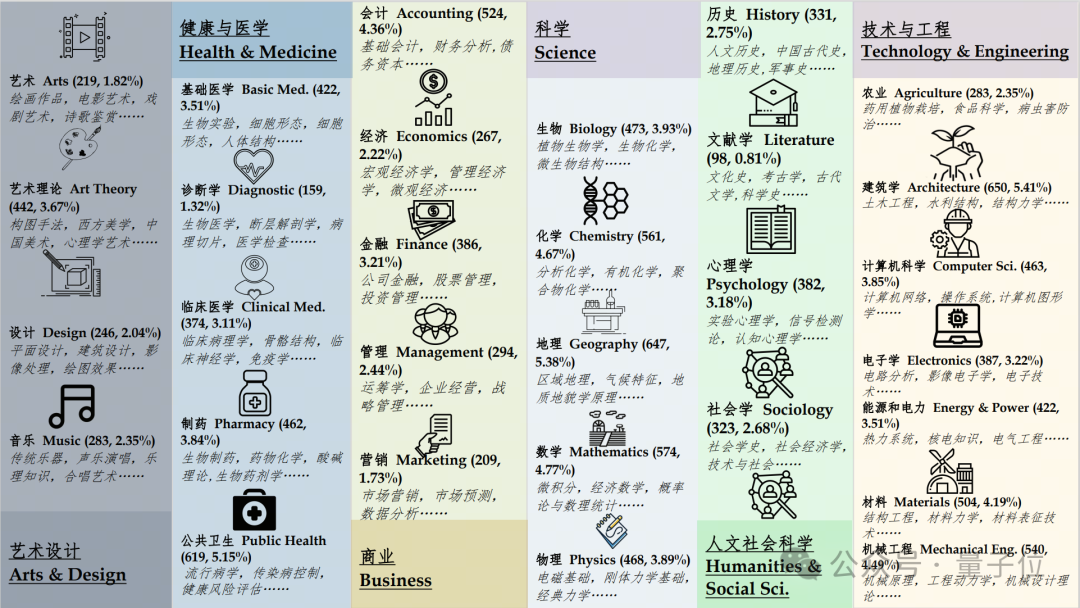
Among them, GPT-4V has an accuracy of 43.7% on this test set, followed by Yi-VL-34B with an accuracy of 36.5%, leading the The current cutting-edge open source multimodal model.
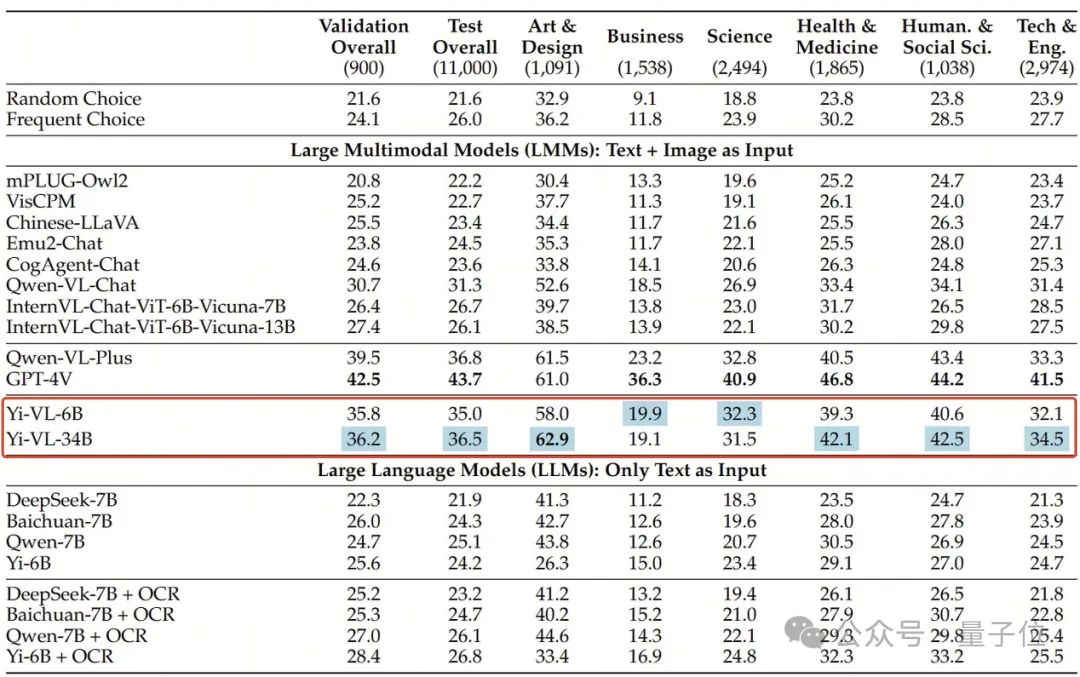
Project address:
[1]https://huggingface.co/01-ai
[2] https://www.modelscope.cn/organization/01ai
The above is the detailed content of Kai-Fu Lee participated in Zero One Wish, which released a world-class open source multi-modal large model.. For more information, please follow other related articles on the PHP Chinese website!

Hot AI Tools

Undresser.AI Undress
AI-powered app for creating realistic nude photos

AI Clothes Remover
Online AI tool for removing clothes from photos.

Undress AI Tool
Undress images for free

Clothoff.io
AI clothes remover

AI Hentai Generator
Generate AI Hentai for free.

Hot Article

Hot Tools

Notepad++7.3.1
Easy-to-use and free code editor

SublimeText3 Chinese version
Chinese version, very easy to use

Zend Studio 13.0.1
Powerful PHP integrated development environment

Dreamweaver CS6
Visual web development tools

SublimeText3 Mac version
God-level code editing software (SublimeText3)

Hot Topics
 Open source! Beyond ZoeDepth! DepthFM: Fast and accurate monocular depth estimation!
Apr 03, 2024 pm 12:04 PM
Open source! Beyond ZoeDepth! DepthFM: Fast and accurate monocular depth estimation!
Apr 03, 2024 pm 12:04 PM
0.What does this article do? We propose DepthFM: a versatile and fast state-of-the-art generative monocular depth estimation model. In addition to traditional depth estimation tasks, DepthFM also demonstrates state-of-the-art capabilities in downstream tasks such as depth inpainting. DepthFM is efficient and can synthesize depth maps within a few inference steps. Let’s read about this work together ~ 1. Paper information title: DepthFM: FastMonocularDepthEstimationwithFlowMatching Author: MingGui, JohannesS.Fischer, UlrichPrestel, PingchuanMa, Dmytr
 The world's most powerful open source MoE model is here, with Chinese capabilities comparable to GPT-4, and the price is only nearly one percent of GPT-4-Turbo
May 07, 2024 pm 04:13 PM
The world's most powerful open source MoE model is here, with Chinese capabilities comparable to GPT-4, and the price is only nearly one percent of GPT-4-Turbo
May 07, 2024 pm 04:13 PM
Imagine an artificial intelligence model that not only has the ability to surpass traditional computing, but also achieves more efficient performance at a lower cost. This is not science fiction, DeepSeek-V2[1], the world’s most powerful open source MoE model is here. DeepSeek-V2 is a powerful mixture of experts (MoE) language model with the characteristics of economical training and efficient inference. It consists of 236B parameters, 21B of which are used to activate each marker. Compared with DeepSeek67B, DeepSeek-V2 has stronger performance, while saving 42.5% of training costs, reducing KV cache by 93.3%, and increasing the maximum generation throughput to 5.76 times. DeepSeek is a company exploring general artificial intelligence
 KAN, which replaces MLP, has been extended to convolution by open source projects
Jun 01, 2024 pm 10:03 PM
KAN, which replaces MLP, has been extended to convolution by open source projects
Jun 01, 2024 pm 10:03 PM
Earlier this month, researchers from MIT and other institutions proposed a very promising alternative to MLP - KAN. KAN outperforms MLP in terms of accuracy and interpretability. And it can outperform MLP running with a larger number of parameters with a very small number of parameters. For example, the authors stated that they used KAN to reproduce DeepMind's results with a smaller network and a higher degree of automation. Specifically, DeepMind's MLP has about 300,000 parameters, while KAN only has about 200 parameters. KAN has a strong mathematical foundation like MLP. MLP is based on the universal approximation theorem, while KAN is based on the Kolmogorov-Arnold representation theorem. As shown in the figure below, KAN has
 Hello, electric Atlas! Boston Dynamics robot comes back to life, 180-degree weird moves scare Musk
Apr 18, 2024 pm 07:58 PM
Hello, electric Atlas! Boston Dynamics robot comes back to life, 180-degree weird moves scare Musk
Apr 18, 2024 pm 07:58 PM
Boston Dynamics Atlas officially enters the era of electric robots! Yesterday, the hydraulic Atlas just "tearfully" withdrew from the stage of history. Today, Boston Dynamics announced that the electric Atlas is on the job. It seems that in the field of commercial humanoid robots, Boston Dynamics is determined to compete with Tesla. After the new video was released, it had already been viewed by more than one million people in just ten hours. The old people leave and new roles appear. This is a historical necessity. There is no doubt that this year is the explosive year of humanoid robots. Netizens commented: The advancement of robots has made this year's opening ceremony look like a human, and the degree of freedom is far greater than that of humans. But is this really not a horror movie? At the beginning of the video, Atlas is lying calmly on the ground, seemingly on his back. What follows is jaw-dropping
 The vitality of super intelligence awakens! But with the arrival of self-updating AI, mothers no longer have to worry about data bottlenecks
Apr 29, 2024 pm 06:55 PM
The vitality of super intelligence awakens! But with the arrival of self-updating AI, mothers no longer have to worry about data bottlenecks
Apr 29, 2024 pm 06:55 PM
I cry to death. The world is madly building big models. The data on the Internet is not enough. It is not enough at all. The training model looks like "The Hunger Games", and AI researchers around the world are worrying about how to feed these data voracious eaters. This problem is particularly prominent in multi-modal tasks. At a time when nothing could be done, a start-up team from the Department of Renmin University of China used its own new model to become the first in China to make "model-generated data feed itself" a reality. Moreover, it is a two-pronged approach on the understanding side and the generation side. Both sides can generate high-quality, multi-modal new data and provide data feedback to the model itself. What is a model? Awaker 1.0, a large multi-modal model that just appeared on the Zhongguancun Forum. Who is the team? Sophon engine. Founded by Gao Yizhao, a doctoral student at Renmin University’s Hillhouse School of Artificial Intelligence.
 AI subverts mathematical research! Fields Medal winner and Chinese-American mathematician led 11 top-ranked papers | Liked by Terence Tao
Apr 09, 2024 am 11:52 AM
AI subverts mathematical research! Fields Medal winner and Chinese-American mathematician led 11 top-ranked papers | Liked by Terence Tao
Apr 09, 2024 am 11:52 AM
AI is indeed changing mathematics. Recently, Tao Zhexuan, who has been paying close attention to this issue, forwarded the latest issue of "Bulletin of the American Mathematical Society" (Bulletin of the American Mathematical Society). Focusing on the topic "Will machines change mathematics?", many mathematicians expressed their opinions. The whole process was full of sparks, hardcore and exciting. The author has a strong lineup, including Fields Medal winner Akshay Venkatesh, Chinese mathematician Zheng Lejun, NYU computer scientist Ernest Davis and many other well-known scholars in the industry. The world of AI has changed dramatically. You know, many of these articles were submitted a year ago.
 Kuaishou version of Sora 'Ke Ling' is open for testing: generates over 120s video, understands physics better, and can accurately model complex movements
Jun 11, 2024 am 09:51 AM
Kuaishou version of Sora 'Ke Ling' is open for testing: generates over 120s video, understands physics better, and can accurately model complex movements
Jun 11, 2024 am 09:51 AM
What? Is Zootopia brought into reality by domestic AI? Exposed together with the video is a new large-scale domestic video generation model called "Keling". Sora uses a similar technical route and combines a number of self-developed technological innovations to produce videos that not only have large and reasonable movements, but also simulate the characteristics of the physical world and have strong conceptual combination capabilities and imagination. According to the data, Keling supports the generation of ultra-long videos of up to 2 minutes at 30fps, with resolutions up to 1080p, and supports multiple aspect ratios. Another important point is that Keling is not a demo or video result demonstration released by the laboratory, but a product-level application launched by Kuaishou, a leading player in the short video field. Moreover, the main focus is to be pragmatic, not to write blank checks, and to go online as soon as it is released. The large model of Ke Ling is already available in Kuaiying.
 The U.S. Air Force showcases its first AI fighter jet with high profile! The minister personally conducted the test drive without interfering during the whole process, and 100,000 lines of code were tested for 21 times.
May 07, 2024 pm 05:00 PM
The U.S. Air Force showcases its first AI fighter jet with high profile! The minister personally conducted the test drive without interfering during the whole process, and 100,000 lines of code were tested for 21 times.
May 07, 2024 pm 05:00 PM
Recently, the military circle has been overwhelmed by the news: US military fighter jets can now complete fully automatic air combat using AI. Yes, just recently, the US military’s AI fighter jet was made public for the first time and the mystery was unveiled. The full name of this fighter is the Variable Stability Simulator Test Aircraft (VISTA). It was personally flown by the Secretary of the US Air Force to simulate a one-on-one air battle. On May 2, U.S. Air Force Secretary Frank Kendall took off in an X-62AVISTA at Edwards Air Force Base. Note that during the one-hour flight, all flight actions were completed autonomously by AI! Kendall said - "For the past few decades, we have been thinking about the unlimited potential of autonomous air-to-air combat, but it has always seemed out of reach." However now,






